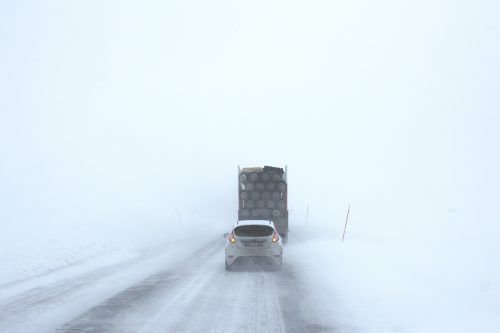Tips for Driving in Wintry Weather
Posted in Automobile on December 1, 2020
With the arrival of Ohio’s first big winter storm, now is a good time to review tips for safe driving on snow and ice. Edmunds published an article with expert advice for staying in control of your vehicle during inclement weather.
Stay Home
The best tip is the most obvious. When faced with difficult weather, it’s usually best to just stay home. If you happen to be traveling when a storm arrives, grabbing a hotel/motel could prove a wise idea. At the very least (if possible), pull over to a rest stop or remain where you are until snowplows have done their work.
Tires are Crucial

Practice extra care when driving in inclement weather.
Your tires get worn down, which is why rotating them regularly is important. Low tread depth is especially dangerous during winter, when conditions are poor. To have adequate snow traction, a tire (even a winter tire) requires at least 6/32-inch deep tread, according to Tire Rack. New passenger-car tires usually begin life with 10/32-inch of tread. If you decide to purchase winter tires, get a full set or stick with all-season tires.
Regularly check your tire pressure. The cold can cause your tire air to contract, which makes your tires much flatter than they need to be. Driving on tires that aren’t at the correct pressure is dangerous and can cause wheel damage. A quick check of your owner’s manual will reveal your vehicle’s optimal tire pressure.
See and Be Seen
Windshield wipers should be replaced every 6 to 12 months. Those who frequently travel in snowy weather should fit wiper blades designed for winter driving.
Clean the inside of your windows thoroughly. Apply a water-shedding material (such as Rain-X) to the outside. Make sure your windshield washer system works and is full of an anti-icing fluid. Run the air conditioner on the “fresh air” option to remove condensation and frost from the interior of the windows.
Check the condition of your headlights. If the covers are opaque, use a polishing agent or fit new covers. When driving, use your headlights—even during the day—so that others will see you. Make sure your headlights and taillights are clear of snow.
Proper Braking
According to Edmunds, “It’s easy to properly use [antilock braking systems]: Stomp, stay and steer.” Stomp on the pedal as if you were trying to snap it off. Stay hard on the pedal and smoothly steer around the obstacle.
If you experience a front-tire skid, it can be corrected. Smoothly release the accelerator, leave your hands where they are and allow the car to slow down. Turning the steering wheel more or pushing the brake pedal is ill-advised.